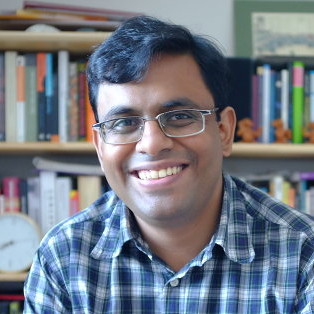Leah Pistorius
March 30, 2022
The Department of Human Centered Design & Engineering welcomed Sayamindu Dasgupta to the faculty as an Assistant Professor in January 2022. Dr. Dasgupta came to HCDE from the University of North Carolina at Chapel Hill, where he was an Assistant Professor in the School of Information and Library Science.

Dr. Sayamindu Dasgupta
Dr. Dasgupta earned his doctorate in Media Arts and Sciences from the Massachusetts Institute of Technology, where he was a part of the Lifelong Kindergarten research group and his work centered around the Scratch programming language and online community.
Read on to learn more about Dr. Dasgupta's research and background, and join HCDE in welcoming him to the faculty.
Can you give us a brief overview of your current research focus?
My research focus is on data literacy for young people, especially in the area of critical data literacy. As our society becomes increasingly data-driven, where everything around us is collecting data and everything around us is being shaped by that collected data, it is important to have more voices involved in shaping these practices and asking questions about how this data is being collected and used. So I am exploring what types of experiences we can design to help young people learn about data practices—such as what data visualization is, or how to create data visualizations—then also how to think critically about these practices. I want to help young people not just recognize the possibilities, but also be able to question those possibilities.
How did you get interested in this field?
I was generally interested in digital literacy and computational literacy for many years before I really started studying it in graduate school. I grew up in India at a time when there was a lot of excitement around the oncoming digital revolution—and rightly so, it has transformed our lives. But I couldn’t help but notice that the computers around us were designed for people who read, write, or speak English. Bengali (my first language), and many other languages that are spoken around the world, were not represented in the language of computer programming or in the languages used on user interfaces. It made me wonder what we are missing by having certain groups excluded from this development. So as technology has grown, and changed fundamental aspects of our society, it became an interest of mine to broaden the group of people who are participating in its creation.
How have you incorporated your research through your teaching?
I have taught courses on programming for data analysis, where I help students ask questions and make discoveries from a set of data they found interesting. I've found that if a student analyzes data that is personal to them, they bring their unique knowledge and vocabulary around this data to make new connections. In that class, students learn to write software to analyze information from public datasets and how to process that data to produce visualizations that answer questions that they are interested in. In HCDE, the first course I will teach is a graduate course on quantitative methods, where I aim to help students sharpen their research questions and figure out new ways to explore their data. I will also co-lead a Directed Research Group for undergraduates where we will study Dataland, our block-based programming system designed to help middle and high-school-aged students learn and do data analysis and visualization.
You are already familiar with UW, having worked as a postdoctoral fellow at the eScience Institute. Can you tell us about what you worked on there?
I was primarily working with Professor Benjamin Mako Hill from the Department of Communication and HCDE Professor Cecilia Aragon to study the Scratch online community—a place where kids share projects they created using the Scratch programming language. We were studying how learning happens within these informal, interest-driven communities, including how kids learned from each other, how the design of the platform influenced their learning, and how the community is run overall. Research that we published at that time, led by Computer Science PhD student Emilia Gan, found differences in how participation happened across different groups like genders.
What excites you about joining HCDE?
I am super interested in how interdisciplinary this department is. My greatest joy in academia has been to work with people who think in different ways about shared concerns. I think HCDE is a place that embodies this, so I'm very excited to be here and look forward to many new collaborations ahead. I have already had the pleasure of working with several HCDE students over the years and have been really impressed with everyone I've worked with. I look forward to meeting everyone, so if you see me in Sieg Building, please say hi!